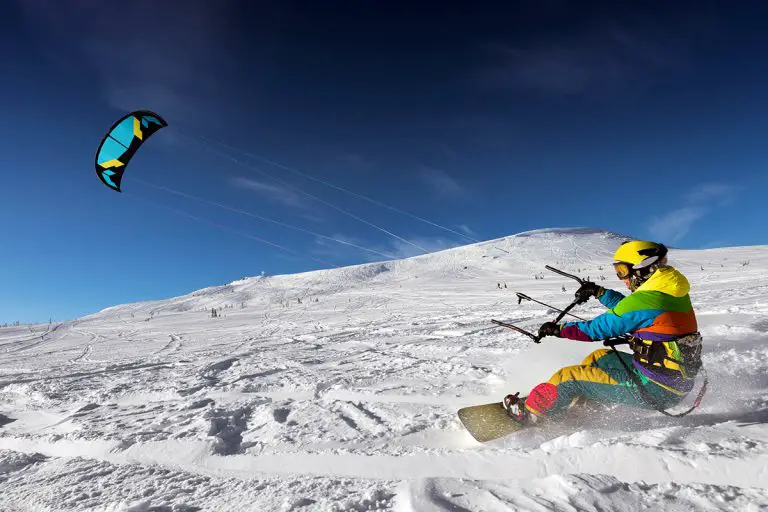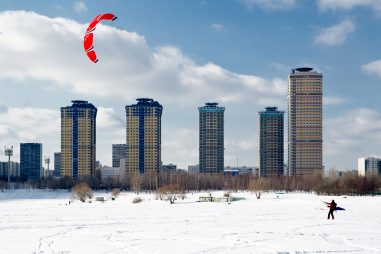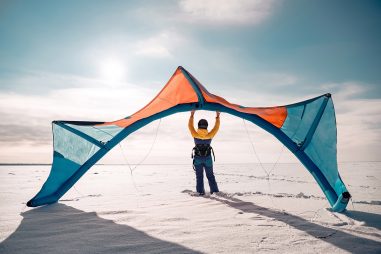Snowkiting has a different kind of rush. With resort skiing and snowboarding, you’re limited to riding downhill every time. But with snowkiting, you get to ride on flat surfaces, uphill, downhill, and in any direction you want.
This thrilling ride is what’s drawing people into the sport. And if you’re reading this, you know your curiosity about snowkiting is getting you excited. So here’s everything you need to know about snowkiting and how you can learn to ride and fly in no time.
What Is the Meaning of Snowkiting?
Snowkiting is a winter sport that uses a kite to propel the rider and cruise on snow or ice. You can use a snowboard, skis, or a split board, whichever you’re most familiar and comfortable with. Think of it like kitesurfing but on snow or ice.
With snowkiting, you harness wind power to pull you and give you momentum and speed. You no longer need to go downhill to accelerate. And the kite allows you to go uphill or cruise on a flat surface and in any direction.
You can snowkite in spacious areas that have consistent air and with thick enough snow or solid ice. You can also go to dedicated snowkiting parks or backcountry terrains in several European countries, the US and Canada.
What Are the Rules of Snowkiting?
Like any sport, there are general safety rules you need to follow to make sure you enjoy your ride. These rules must be followed for everyone’s safety.
- Never ride alone. You’ll need someone to help you when accidents happen.
- Make sure your chosen area is free of any obstacles like power lines, trees, and buildings. It’s also not advisable to ride in public areas where you can hit other people as you ride.
- If there’s a road in the area, make sure you launch or land at least 150 meters away.
- When snowkiting on frozen lakes, inspect the surface evenness, ice thickness, and strength. Don’t ride on frozen lakes with cracks or water on the surface.
- To prevent collisions with other riders, always look in every direction before launching.
- Make sure to wear the proper safety equipment.
- Warm-up before your ride.
Understanding rules and guidelines make for a responsible rider. It’s not just for your safety and enjoyment but for the other riders’ as well.
What Is Snowkiting Like?
If you’ve experienced kitesurfing or wakeboarding, snowkiting is almost the same experience. The main differences are the environment and the gear you’re using and wearing.
Riding the snow is also comparable to skiing or snowboarding, minus the constant downhill direction. With snowkiting, you can cruise on a flat surface or go over the hill to fly again and again.
Haven’t experienced any of those? Well, if you’ve ever flown a kite, imagine flying one big enough to pull you at a speed of at least 12 kph. Still can’t imagine it? You can check out videos online to get a look at what snowkiting is like.
Snowkiting vs. Kitesurfing
The two sports are very similar and kitesurfers who take on snowkiting often find the transition seamless.
Flying the kite is the same for both sports. The skills needed to control, maneuver, execute tricks and certain moves are the same.
The differences lie in the following areas:
- Environment: This is the most obvious difference. Surfing on water is a different feeling since you’re moving on liquid matter. It can get wobbly when you’re not moving, so you’ll need a greater sense of balance. And in case you fall, you’ll find yourself sinking and soaked. Such isn’t the case with snow, but you’ll have to contend with the extreme cold.
- Wind strength: You’ll need less wind power to ride on snow versus on water.
- Kite used: Leading Edge Inflatable kites can be used for both land and water. Meanwhile, foil kites are ideal for land use only.
- Kite launching: In snowkiting, you can relaunch your kite by yourself in case it crashes. For kitesurfing, you can’t do this if it happens in the water. It’s possible to re-launch from the beach but it can be quite challenging.
- Safety gear: Aside from wearing outdoor winter gear, snowkiting requires additional safety gear. There are additional risks of injury as crashes and collisions on land usually hurt more than on water.
Is Snowkiting Dangerous?
Before you get into snowkiting, you need to understand that it’s not dangerous but it can be risky if you don’t follow the proper safety protocols.
The general safety rules have been listed above, but there are more precautions to be followed. It’s highly recommended that first-time snow kiters attend seminars on the rules and safety.
Kite designs are also much safer now. They’re equipped with a safety system that lets you disconnect from the kite if needed. This prevents you from being pulled and carried away by strong gusts.
It’s also required to wear safety gear whenever you ride. Helmets, goggles, and body support are just some of the things you need to minimize serious injuries.
How Fast Can You Go Snowkiting?
Snowkiting speed depends on several factors. As far as the fastest you can go, there are unofficial reports that the world speed record for snowkiting is 142 kph. Details are scarce but he rode downhill with wind speeds of 30 knots (55.5 kph).
Below are the factors that will determine how fast you can ride:
- Wind speed: The higher the speed, the faster you can go. But you can already enjoy kitesurfing at wind speeds of 12 kph.
- Friction: More friction can slow you down. Ice has less friction than snow. If you’re snowkiting on wet powder, expect a lot of resistance.
- Altitude: Winds are less dense at high altitudes, making them stronger than the winds in low snowkiting altitude locations.
- Obstruction: You can harness wind power more efficiently if the wind can travel unobstructed for long distances over a wide area. Obstructions like trees, buildings, and power lines, disrupt wind flow.
- Gear: Certain skis and freestyle snowboards tend to be faster on soft snow.
- Kite Type: Training kites won’t allow you to use as much wind power compared to foil or LEI kites.
- Skill level: Naturally, the more skilled you are, the faster you can ride.
How Dangerous Is Snowkiting Actually
Snowkiting is a generally safe sport as long as you follow the safety guidelines and the sport’s general rules. But it can be dangerous if you ignore these guidelines. And there are natural dangers such as:
- Avalanches: You can’t predict when an avalanche can happen. That’s why it’s critical to always bring your avalanche safety gear if you’re riding in the remote backcountry areas in the mountains.
- Unfamiliar terrain: There’s a reason why riding on unfamiliar terrain is highly discouraged. Hitting tree stumps, tripping over crevices, and falling over cliffs can all lead to serious injury or even death.
- Extremely powerful winds: Riding with extremely powerful winds is dangerous because it’s easy to lose control of your kite. It can drag you on the ice or you can be pulled up and come crashing down easily.
To avoid these natural dangers, the rule of thumb is to always check the following when planning your ride:
- Weather report: Never ride in bad weather conditions.
- Wind conditions: If winds are too strong and gusty, you should reschedule your ride.
- Surface conditions: If the area is uninspected or there are danger zones, look for another place to ride.
Who Invented Snowkiting?
Snowkiting’s invention is credited to German Dieter Strasilla, a German national. In the 1960s, together with co-experimenters, he was trying to develop a new way to ski using wind propulsion. By 1972, he was able to create the snowkite prototype, a contraption that made it possible to glide on snow and fly. Thus began snowkiting as a sport.
The sport evolved throughout the 80s and was first fully embraced by Americans. Soon after, the rest of the world did the same.
Where Was Snowkiting Invented?
Dieter Strasilla first conducted his snowkiting experiments in his home country of Germany. But other people conducted their own trials and experiments in other countries.
Wolf Beringer’s parawing system was used in several polar expeditions in the 1980s. The first foil kites were used in Wisconsin. Meanwhile, kite skiing was demonstrated in Switzerland, Germany, Poland, and Finland.
How Do I Start Snowkiting?
Assuming that you don’t know how to kitesurf, one of the first things you have to do to start snowkiting is to learn how to fly a kite. It’s the most essential part of the sport and it’s something you have to learn before anything else.
You’ll have to start with trainer kites that you can fly anytime on your own. Once you’re confident enough to take the training wheels off, you can move on to power kites. However, you’ll have to take lessons since power kites are a different animal from training kites.
The second thing you need to do is to watch instructional videos. You can find the following useful tips in these videos:
- Kite flying basics and tips.
- Wind awareness and orientation.
- Environmental assessment.
- Importance of weather forecast and reading the sky.
Lastly, before you take snowkiting lessons, be sure you’re equipped with the right gear. The essentials include:
- A helmet.
- Goggles, preferably tinted ones to give your eyes UV protection.
- Body armor and joint support. Expect to fall several times as you learn so you should protect yourself at all times.
Before buying gear, it’s a wise move to ask the experts or experienced riders first. They can tell you which are the reliable brands that you should be using. They can also give you the lowdown on how to inspect your gear and spot and faulty mechanisms or existing damages that can lead to accidents.
How Can I Learn Snowkiting?
The only way to learn to snowkite is to take lessons. This is critical if you don’t know how to kitesurf. Learning to snowkite or kitesurf on your own is difficult and highly discouraged. You need the pros to guide you and instruct you and prevent you from getting seriously hurt.
Instructors educate you on proper kite flying and snowkiting basics including board skills. But most importantly, you learn the general safety rules and guidelines to make it a safe experience for you and your fellow riders.
You can find snowkiting lessons online or at your nearest snowkiting centers.
The Basics of Snowkiting
Snowkiting comes down to four fundamental steps. Learning each one is what can make you a better and safe rider.
- Safety and Setup: This involves understanding the weather and environment of your chosen location, familiarizing yourself with your equipment, and ensuring that all safety guidelines are met. Only then can you set up your kite to launch.
- Kite Launching and Landing: This is about the basics of launching and landing your kite. There’s a right way to launch to ensure you get a smooth ride. Meanwhile, proper landing is important to make sure you hit a dead stop and you don’t get accidentally blown away with your kite.
- Flying and Riding: Kite flying involves control and power. Understanding the control is key to riding, executing tricks, as well as stopping.
- Packing: When you’re done for the day, you’ve got to pack your kite the right way. Whether assisted or solo, there are specific steps to be followed to ensure your kite remains in good condition to be used again and again.
How Do I Launch a Snowkite?
There are two ways to launch a kite: assisted or unassisted. Either way, always check your harness, loops, and other mechanisms before launching.
Assisted Launching: It’s recommended that beginners launch their kites with help. It’s ideal that it’s someone who’s familiar with the wind window and knows how your kite flies. This way, they know when to launch the kite safely and instruct you on which direction it’ll fly and you’ll ride.
Self-Launching: You can practice self-launching once you’ve gotten more confident in your kite control and flying skills. To launch your kite, you’ll have to walk with your bar while making sure the kite is on the wind window side.
When you’re all set, step back and slowly let the kite fill with air, and watch it take flight. Bring it to the 12 o’clock position once fully inflated so you can test its power and your control.
How to Jump With a Snowkite?
Once you’ve learned the basics, one of the first tricks you can learn is to kite jump. For this trick, you let your kite lift you so you can jump from the ground, take flight, and land gently. As a beginner, you should first practice small jumps. Taking high or long jumps as a beginner can result in broken bones and a bruised ego.
Before practicing your jump, you need to check that your take-off and landing area are free of any obstacles. You also need to move at a moderate speed with the snowkite in a downwind direction to get enough momentum. Your bar position should be at 11 or 1 o’clock, depending on the direction you’re going.
Once you’re ready, here are the steps to execute the move:
- Raise your kite slowly to a 12 o’clock position.
- At the 12 position, pull in the bar to launch yourself upwards.
- As you descend, move the kite slowly back to its original position so you can continue riding as you land.
Beginners need to start small to prevent injuries. Consider a small successful jump as a huge win. Continue practicing until the move becomes automatic.
How to Snowkite Upwind
Snowkiting upwind means riding against the wind direction. If you’ve ever walked towards the wind on a very windy day, you know how hard it can be. So before you attempt riding upwind, your basic snowkiting riding and stopping skills should be polished.
Here are the general steps to ride upwind:
- Head downwind to get power and momentum until you reach cruising speed.
- Lean back into the harness to get your weight onto your heels.
- This heelside railing position allows the board to ride upwind.
Snowkiting Tips for Beginners
Snowkiting is an exciting sport but there are no shortcuts to becoming a good rider. Beginners will do well to master the fundamentals for safety and to make learning advanced moves a lot easier. Here are a few tips beginners should take to heart when learning how to snowkite.
- Be properly equipped: Wearing the right gear protects you from extreme cold and injuries. There’s no shame in wearing body armor or elbow/knee pads if it means being able to ride as much as you want.
- Learn with and from friends: It’s a lot more fun to learn with people you know. Aside from your instructors, your friends will be more than happy to teach and help you learn.
- Follow all safety guidelines: Safety is the number one priority in snowkiting. Following all safety guidelines can prevent injury or save lives.
- Borrow a trainer kite. You’ll be using a trainer kite only at the beginning of your snowkiting journey. It’ll be of no use once you move on to power kites. Save yourself some cash and borrow one instead.
- Perfect self-launching and landing techniques. Even if you’re not riding alone, it’s still useful to learn how to self-launch your kite. Landing is critical when jumping and doing other tricks. Poor landing technique puts you in harm’s way.
- Start on flat ground. Expect to fall a lot at the beginning. This is why practicing on flat terrain with powder snow is your best bet. It won’t hurt as much as ice so you can keep practicing without being too sore.
- Have fun: Enjoy every moment. Having fun is what will make you go back to snowkiting every time.



